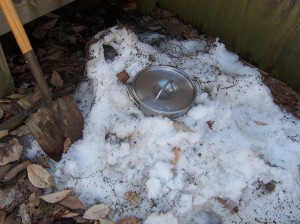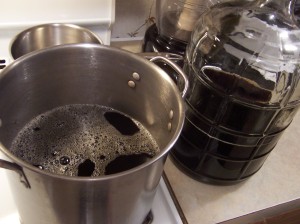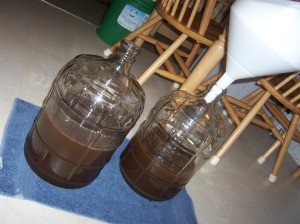It goes without saying that springtime is a season of rebirth. We are right at the end of this year’s spring thaw; there is still some snow on the ground (that actually came in quite handy today), and the mud is starting to harden up.
The onset of spring is particularly evident to a gardener, to one who works with the Earth in its fecundity to sustain the family and the tribe. My Uncle John was a gardener (among many other things). Uncle John passed away this morning (while the chaga sap decoction was simmering on the stove), and I’ve named today’s mead after him. Mead is a bridge to the past and the future. Humans have been making mead as far back in history as we can see, and a bottle of mead preserves its ingredients for posterity and future nourishment. Today, as I make mead, I am thinking of John. He was a good man, a beacon of kindness in his family and his community. Today my heart is with him, with my family, and with those who loved him. Hail!
It is sap season here in Maine, so I’m going to start with several gallons of freshly harvested maple sap from one of my wife’s coworkers who lives nearby. Apart from using sap instead of spring water, I am more or less replicating what has become my favorite mead recipe, Mad Trad D.
I did a long chaga decoction in 3 gallons of the sap, letting it go for almost 18 hours, with 1 sumac drupe infusing at the end (off the heat). Unfortunately our sink stopper seems to have abandoned the premises, so I had to improvise on cooling down the tea:

As you can see, I used one of the last patches of snow in the shade to cool the tea and it worked beautifully. After the tea was cool, I started the double batch, pouring half of the cooled, filtered tea into my 3 gallon stockpot:

I mixed in enough of the new bucket of Maine Wildflower 2013 honey I picked up recently to get to 18% alcohol. 2013 was a tough year for Maine apiaries, but this honey is fantastic. Some honey has an overtone of tartness to it, but this honey is much smoother than that, reminding me of smoke & caramel.
When the first batch was mixed up, mixing the 1.5 gallons of tea, with extra sap and enough honey to get to 18% alcohol potential, I split it equally into the 2 carboys, each with Red Star Montrachet yeast inside:

Then I mixed up the second batch to 18%, and poured it into the 2 carboys to top them off. The must (sugary liquid that will become mead) tasted fabulous, almost like a syrup. This should make an outstanding mead, which is no surprise. Uncle John was a great fermenter, and made the best pickles (cucumbers and onions) from the vegetables he’d grown himself. Therefore another fermentation dedicated to John is sure to come out spectacular.
I look forward to some time in the coming years when I gather again with John’s branch of my family. I will bring some of John’s Springtime Traditional Mead to share with them on that day, so that we can raise our glasses to John and remember him. Hail!
UPDATE, April 18: Stuck Fermentation
After these 2 batches had been sitting for several days, there still was no sign of fermentation; the airlock wasn’t moving at all and there were no tiny CO2 bubbles rising in the must. This is called a stuck fermentation, and it had never happened to me before!
After doing some research, I am pretty certain that the fact that the sap I used was cloudy is the culprit. This indicates the presence of microorganisms in the sap, and most likely they were interfering with the normal yeast activity. Cloudy sap is normally dealt with by cooking it down normally into maple syrup, where the cloudy sap produces Grade B Maple Syrup with its associated richer flavor reminiscent of caramel and molasses, and the presence of many more minerals.
As my regular readers will know, I do not recommend boiling the honey-liquid, the “must,” but in this case there was little choice. I emptied one of the carboys back into my stockpot, carefully brought it to a boil to kill off any microorganisms (including the yeast I’d pitched), cooled it down to blood temperature, and put it back into the carboy with some new yeast. Voila! This morning it was bubbling away normally! Great news.
Today I will take care of the other batch in the same way.
UPDATE: August 11
I racked the mead today, and it came out at 3% alcohol potential, which means it’s 15% ABV and sweet. It has a maltier flavor to it, presumably from the fact that the mead was boiled. This mead is already quite clear, so I will be bottling it soon.
